Green basil - benefits and harm
Basil belongs to the vegetable crops of the Yamnotaceae family. Both types of plants (green and purple) are widely used for medicinal and preventive purposes, as well as in cooking as a seasoning for meat dishes, sauces, marinades, desserts and drinks. Residents of European countries, unlike Asian ones, prefer green varieties of spices, since their taste is softer and more aromatic.
What does green basil look like?
The herbaceous plant has a branched shape and is a bush with shoots of about 50-70 cm. The leaves are oblong, with denticles along the edges, covered with small hairs. When flowering, a brush or spikelet with white, light pink or purple inflorescences (5-10 flowers each) is formed at the tips of the stems.
The taste of greens is salty and tart.. Breeders have received many different varieties with vanilla, menthol, and lemon aromas.
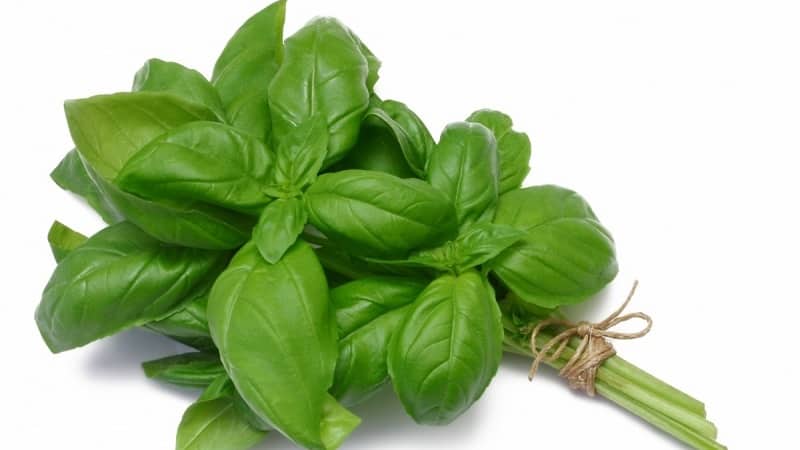
Chemical composition and calorie content of fresh basil
100 g of greens contains about 23 kcal. The share of carbohydrates is 1.1 g, protein – 3.2 g, fat – 0.64 g. This portion includes:
- water – 92 g;
- dietary fiber – 1.6 g.
100 g of spices are also included:
- vitamin A – 264 mcg;
- vitamin K - 415 mcg;
- tocopherol – 0.8 mg;
- ascorbic acid – 18 mg;
- folic acid – 68 mcg;
- vitamin B1 – 0.03 mg;
- vitamin B2 – 0.1 mg;
- vitamin B5 – 0.21 mg;
- vitamin B6 – 0.16 mg;
- nicotinic acid – 0.9 mg.
The amount of macro- and microelements is as follows:
- calcium – 178 mg;
- potassium – 295 mg;
- magnesium – 65 mg;
- phosphorus – 55 mg;
- iron – 3.18 mg;
- copper – 0.4 mg;
- selenium – 0.3 mcg;
- zinc – 0.8 mg.
The product contains saturated (0.04 g) and polyunsaturated (0.4 g) fats, numerous essential and non-essential amino acids.
Interesting things on the site:
How to prepare and take basil remedies for weight loss
What are the benefits of basil oil and how to use it correctly
The benefits and harms of green basil
The beneficial components found in the spice have a healing effect on the body.. The product is an effective preventive and therapeutic agent.
Medicinal and beneficial properties
When regularly introduced into the diet, green basil positive changes occur in the state of the body:
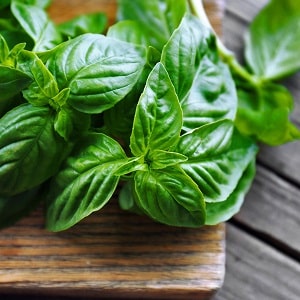 immunity is strengthened;
immunity is strengthened;- digestion and the process of absorption of useful components are normalized;
- the state of the nervous system improves and its resistance to stress increases;
- sleep patterns are normalized;
- mental activity is stimulated;
- the state of the body as a whole is toned.
There will be basil useful for viral respiratory tract infections, as it promotes:
- removal of sputum;
- reducing high temperature;
- relief of symptoms of the disease.
Greens have a positive effect on the sexual sphere of men. It increases potency and improves the quality of sexual life.
Wound healing and anti-inflammatory properties plants are used in the treatment of oral mucosa: stomatitis, sore throat. Fresh herbs not only eliminate ulcers, but also effectively cleanse tooth enamel from stones and plaque and prevent the development of caries.
Basil is recommended for people with problems with the cardiovascular system due to its ability to effectively cleanse blood vessels of cholesterol plaques.The essential oils of the plant contain a large amount of antioxidants, which protect against the development of tumors and slow down the aging process.
Important! Greens are also indispensable during weight loss. The product is low in calories, but at the same time contains almost all the necessary substances for the normal functioning of the body. It provides a feeling of satiety, and the fiber in its composition helps cleanse the body of toxins and toxic substances.
Contraindications
There are a number of restrictions on the use of the product that you need to pay attention to.
Among the contraindications:
- epilepsy;
- the period after a heart attack or stroke;
- diabetes.
People using blood thinners, it is also not approved for use, because the product promotes increased blood clot formation.
It is recommended to use basil with caution during pregnancy. Excessive amounts of greenery can lead to increased uterine tone.
Attention! Frequent use of fresh spices for medicinal purposes negatively affects tooth enamel.
Varieties of Fragrant Green Basil
The plant is in demand by owners of household plots and summer cottages. It is also grown at home on the windowsill.
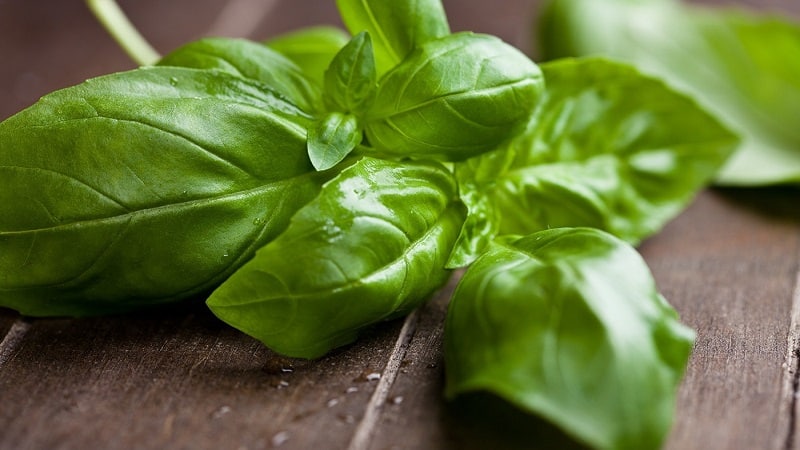
Preference is given to the following varieties:
- Basilisk. The bush is low (about 20 cm), has small smooth leaves and white inflorescences. It has a peppery-clove aroma that is well suited for marinades and fresh salads. The ripening period after emergence is 1 month.
- Greek. It has a spherical shape and reaches a height of 15 cm. The plant is used not only in cooking, but also to decorate any interior. The taste of greens is sweet and spicy. Suitable for sauces, marinades and fresh salads.The leaves are consumed 2 months after the first shoots appear.
- Clove. Grows up to 60 cm. Has elongated bright green leaves. The color of the inflorescences is white. The spice has a characteristic smell that is perfect for meat dishes. Gives a good harvest. The greens are suitable for consumption 1 month after germination.
- Gourmet. The plant has large leaves and grows up to 25 cm. It has a pronounced aroma and taste. Suitable as an addition to salads and main courses. Greens are suitable for drying, pickling and freezing. The spice begins to be used 1.5 months after germination.
- Caramel. The caramel-fruit taste of the plant allows it to be included not only in vegetable salads, but also in confectionery and drinks. The variety has large, fleshy leaves that are suitable for consumption within 1 month after germination. Productivity is high - 3 kg per 1 sq. m.
- Naughty. The bush forms many shoots. The leaves have an aromatic and delicate taste. The variety is intended for growing both in flower pots and in the garden. It is used for canning food and as a seasoning for fresh salads, fish and meat dishes. Productivity is average (about 1800 g per 1 m2).
- Thai Queen. Refers to decorative varieties. It is distinguished by luxurious flowering. The clusters are dark purple in color, reminiscent of lilacs. It is grown at home on a windowsill, in a greenhouse and in open ground. The leaves are eaten throughout the growing season.
Other varieties:
How to Plant Green Basil
Basil is a heat-loving plant crop. That's why it is preferable to grow it in seedlings.
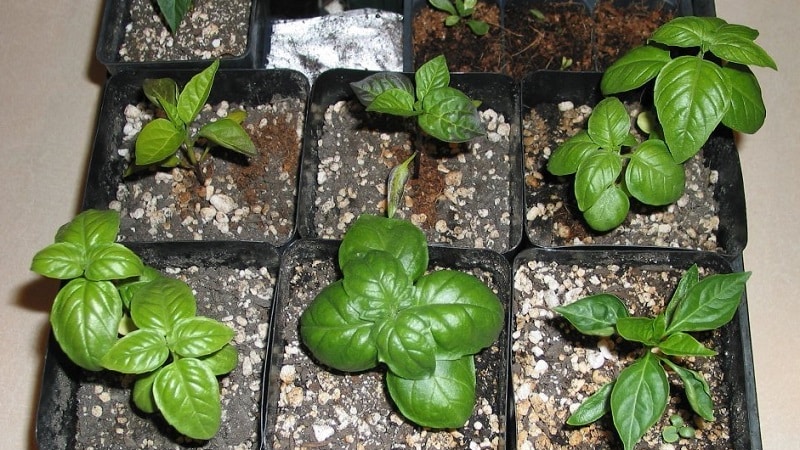
Sowing seedlings
Optimal seed sowing time - end of March. After the first shoots appear, the seedlings are usually ready for transplantation after 1.5 months.
The soil mixture for basil is prepared according to the following scheme:
- Take peat, humus or compost, as well as sand in a ratio of 4:2:1.
- Steam the composition in a water bath for about 1 hour to destroy pathogenic bacteria and seeds of other plants.
They also use a ready-made soil mixture, which can be purchased at a specialized store. Before sowing, it is recommended to treat such soil with a solution of potassium manganese. or one of the drugs against fungal spores: “Fitosporin” or “Maxim”.
A container with a height of about 7 cm is ideal for sowing seedlings., it is filled with soil almost to the very edge.
Attention! Special cassettes are often used for sowing basil.
Sow in several stages:
- The seeds are evenly distributed over the surface and lightly sprinkled with soil so that they are at a depth of about 1 cm.
- The soil mixture is slightly compacted and carefully watered.
- cover the container with glass or plastic film and place it in a place with a temperature above +20°C.
- When the seeds sprout (after 10-14 days), the glass and polyethylene are immediately removed and the seedlings are moved to a room with a cool temperature (+15...+19°C) so that they do not stretch.
- Water regularly with slightly warmed water.
Important! Excessive waterlogging of the soil is harmful to the plant crop, as it leads to blackleg damage.
After 2-3 leaves appear, the seedlings dive into other containers. Ash (2 tbsp) and mineral fertilizer (1 tbsp) are added to the soil (5 l), and the soil is mixed well.
Small depressions are made in the soil and seedlings are placed in them, without deepening them too much and trying not to damage the root system. Water as needed.
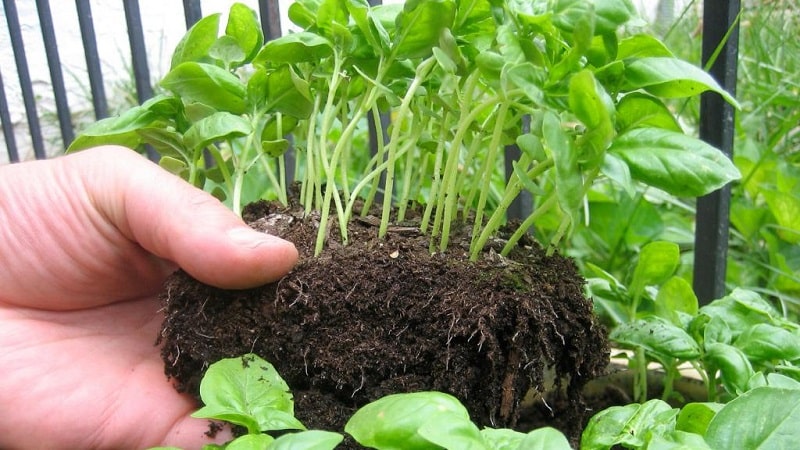
How to plant in open ground
Ready seedlings are transplanted into open ground according to this scheme:
- Leave about 20-25 cm between plants, and 35 cm between rows.
- When planting in a staggered pattern, I plant the seedlings approximately 30 cm apart.
Follow the following procedure:
- Make grooves or pits (optional).
- The depressions are well moistened with warm water.
- Plants are transplanted to a permanent place of growth along with a lump of soil.
- Sprinkle with dry soil, leaving the central bud with leaves outside.
- Compact the earth.
In the middle zone and in the southern regions, basil can be planted in open ground and with seeds. Sowing is carried out at the end of April - in May (depending on the climatic zone). The soil is well loosened and furrows are made, leaving row spacing about 40 cm wide. The seeds are planted to a depth of 1.5 cm and the soil is slightly compacted.
When 2-3 leaves appear, thin out the basil, leaving a distance of about 20 cm between individual plants.
Conclusion
If you plant the spice correctly and water it regularly, the harvest can be harvested throughout the growing season. It is recommended to break off the tops of shoots with several leaves, as they are the most fragrant and healthy. When harvesting, the stems are cut off entirely so that new ones can grow.